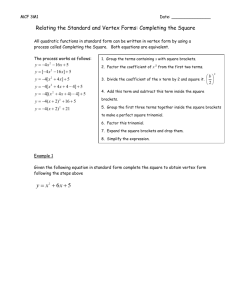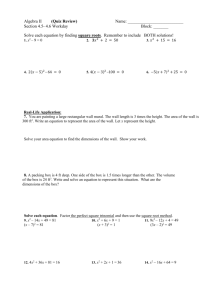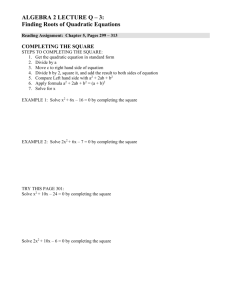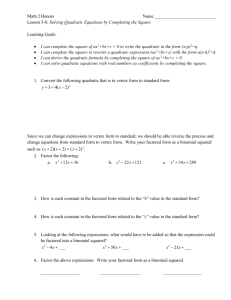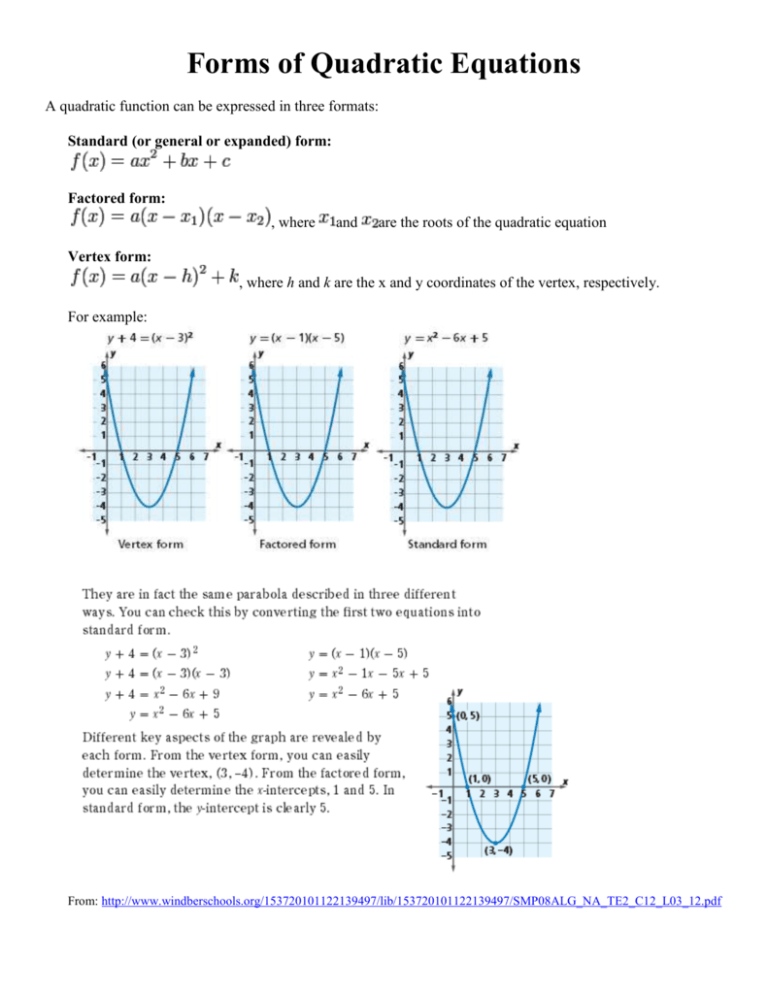
Forms of Quadratic Equations
A quadratic function can be expressed in three formats:
Standard (or general or expanded) form:
Factored form:
, where
and
are the roots of the quadratic equation
Vertex form:
, where h and k are the x and y coordinates of the vertex, respectively.
For example:
From: http://www.windberschools.org/153720101122139497/lib/153720101122139497/SMP08ALG_NA_TE2_C12_L03_12.pdf
Converting Between Forms of Quadratic Equations
To convert the standard (expanded) form to factored form, one could:
1. A "quadratic" is a polynomial that looks like "ax2 + bx + c", where "a", "b", and "c" are just numbers. For the
easy case of factoring, you will find two numbers that will not only multiply to equal the constant term " c",
but also add up to equal "b", the coefficient on the x-term. For instance:
Factor x2 + 5x + 6.
I need to find factors of 6 that add up to 5. Since 6 can be written as the product of 2 and 3, and since 2 + 3 = 5,
then I'll use 2 and 3. I know from multiplying polynomials that this quadratic is formed from multiplying two factors
of the form "(x + m)(x + n)", for some numbers m and n. So I'll draw my parentheses, with an "x" in the front of
each:
(x
)(x
)
Then I'll write in the two numbers that I found above:
(x + 2)(x + 3)
This is the answer:
x2 + 5x + 6 = (x + 2)(x + 3)
This is how all of the "easy" quadratics will work: you will find factors of the constant term that add up to the middle term,
and use these factors to fill in your parentheses.
See lots of examples at http://www.purplemath.com/modules/factquad.htm
This becomes slightly more complicated when the “ a” coefficient is not 1.
To factor a "hard" quadratic, we have to handle all three coefficients, not just the two we handled in the "easy" case,
because the leading coefficient (the number on the x2 term) is not 1. The first step in factoring will be to multiply "a" and
"c"; then we'll need to find factors of the product "ac" that add up to "b".
Factor 2x2
+ x – 6.
Looking at this quadratic, I have a = 2, b = 1, and c = –6, so ac = (2)(–6) = –12. So I need to find factors of –12
that add up to +1. The pairs of factors for 12 are 1 and 12, 2 and 6, and 3 and 4. Since –12 is negative, I need
one factor to be positive and the other to be negative (because positve times negative is negative). This means
that I'll want to use the pair "3 and 4", and I'll want the 3 to be negative, because –3 + 4 = +1. Now that I have
found my factors, I will use what my students refer to as "box": I will draw a two-by-two grid, putting the first term
in the upper left-hand corner and the last term in the lower right-hand corner, like this:
Then I will take my factors –3 and 4 and put them, complete with their signs and variables, in the diagonal
corners, like this:
(It doesn't matter which way you do the diagonal entries; the answer will work out the same either way!)
Copyright ©
Elizabeth Stapel 1999-2009 All Rights Reserved
Then I'll factor the rows and columns like this:
from the top row
from the bottom row
from the left column
from the right column
(Note: The signs for the bottom-row entry and the right-column entry come from the closest term that you are
factoring from. Do not forget your signs!)
Now that I have factored the box, I can read off my answer from across the top and along the left-hand side:
2x2 + x – 6 = (2x – 3)(x + 2).
2. use the quadratic formula to determine the two roots (more about this later)
To convert the factored form (or vertex form) to standard form, one needs to
multiply, expand and/or distribute the factors.
For example:
Vertex to standard:
Factored to standard: use an area diagram with the factors as dimensions
To convert the standard form to vertex form, one needs a process called
completing the square.
Completing the Square
Say we have a simple expression like x2 + bx. Having x twice in the same expression can make life hard. What
can we do? Well, with a little inspiration from Geometry we can convert it, like this:
As you can see x2 + bx can be rearranged nearly into a square ...
... and we can complete the square with (b/2)2
In Algebra it looks like this:
x2 + bx
+ (b/2)2
"Complete the Square"
=
(x+b/2)2
So, by adding (b/2)2 we can complete the square.
And (x+b/2)2 has x only once, which is easier to use.
Keeping the Balance
Now ... you can't just add (b/2)2 without also subtracting it too! Otherwise the whole value would change.
So I will show you how to do it properly with an example:
Start with:
("b" is 6 in this case)
Complete the Square:
Also subtract the new term
Simplify it and we are done.
The result:
x2 + 6x + 7 = (x+3)2 - 2
And now x only appears once, and your job is done!
From:
http://www.mathsisfun.com/alge
bra/completing-square.html
Examples:
Completing the Square when you’re a coefficient (in standard form) is 1.
Completing the Square when you’re a coefficient (in standard form) is not 1.
Here are the steps for solving 2x2 + 8x +11
2x2 + 8x +11=0
Original equation set to 0 (set this to zero since the y value of 0 is where the xintercepts/solutions are found)
2
2x + 8x= -11
Subtract 11 from both sides
2
2(x + 4x)= -11
Factor out the 2 from the coefficients from the left side of the equation
2(x2 + 4x + 4) = -11+8
Divide the b coefficient by 2 and square it to find the c that makes perfect square
trinomial (4/2 = 2; 22=4). Since you added the 4 x2 to left side of the equation to
make it a perfect square trinomial, you need to add 4 x2 to the right side of the
equation also to keep the equation balanced
2(x+2)2= -3
Simplify the right side of the equation, express the perfect square trinomial on the
left as a squared binomial
2 −3
Solve for x. First divide both sides by 2.
(x+2) = 2
Take the square root of both sides
−3
x+2=√
2
−3
𝑥 = −2√
2
Subtract 2 from both sides. These roots do not represent real numbers because the
number under the square roots sign is negative. Since every real number is on the
x-axis, this is not. Therefore, this equation does not have roots (x-intercepts) and so
has no solution.
Quadratic
Functions
What information you have:
1.
How to find
the
2.
solutio
ns
(also called
roots or xintercepts)?
1.
Use the Zero Product
Property to find the two
roots.
1.
Find the midpoint of the
roots (which will be the xcoordinate of the vertex),
plug x back into the original
equation to solve for y.
Then you have your (x,y)
for the vertex.
2.
Force the standard form to
become a perfect square
trinomial (vertex form) by
“completing the square”.
Solve using square roots. Set f(x) or y
equal to zero since y = 0 at the xintercepts.
Then solve using square roots.
3.
4.
1.
How to find
the
Graph the standard form
equation in the graphing calc
and zoom in on the x-intercepts
with the table or graph.
Use the quadratic equation:
Force the standard form to
become a perfect square
trinomial (vertex form) by
“completing the square”.
Then look for the vertex in the
equation (where h and k are the
x and y coordinates of the
vertex, respectively).
vertex
(also called
maximum or
minimum)?
Change the standard form
equation into factored form by
finding a factorable trinomial
=
2.
Graph the standard form
equation in the graphing calc
and zoom in on the vertex with
the table or graph.
3.
Change to factored form (see
above), find the midpoint of the
roots (which will be the xcoordinate of the vertex), plug
x back into the original
equation to solve for y.
1.
Look for the vertex in the
equation:
where h and k are the x and y
coordinates of the vertex,
respectively.
Practice Problems
1. Given the following quadratic Function (given in both standard and factored form), find the coordinates
of the vertex and determine if there is a minimum or a maximum.
= (x+1) (x+3)
6. Rewrite
7.
in general form.
Answers


